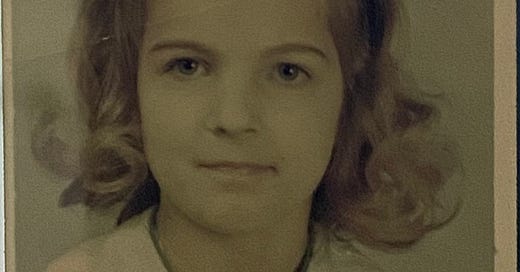Photo of author in 1st grade
I feel the drumbeat of writing teachers of yore walking up and down aisles of desks skewed approximately in line. “Consider your reader,” they said. My 2nd grade teacher, Mrs. Edwards, reinforced this message with a well-placed crack of the yardstick on a few desks. Including mine. Well, the only reader that mattered then was the teacher. We all wanted to see that “A” on our papers. And a smiley face.
Now that I am beyond teachers and smiley faces, I still have to ask the same question. “Who will read my work?” What does the imaginary person on the other side of my words care about? How are they experiencing what I have written?
Before I can answer any of those questions, I have to step back to the first reader-me. You may not be able to tell, but my first grade picture above is of a young girl who that year was transformed by reading. I look at her and imagine what it must have been like to choose her own books, and to read and not always be read to. In the time before pre-schools, children started to read and write in first grade. It was much more of a momentous year than it is now where children learn these skills earlier.
Today, after a winding career path through finance, raising our daughters, and doubting myself, I honor that 6-year-old, and focus on writing. Counting myself as the first audience matters deeply. If I am not moved by my story, probably no one else will be. By writing first for myself, I discover what I really mean before I try to describe it to anyone else. I am the first one to feel the undercurrent of emotions that go along with the characters and events in the story. And for the first draft, I can write bravely, without censoring too soon.
From a practical sense, I am the one who chooses the words. Like a painter who picks up a certain brush and mixes just the right color, the words have to resonate with me. They have to please me as I see them on the page. I have to be happy that they convey the pictures and ideas from my imagination to the best of my ability. Like brushstrokes, I paint a rhythm with my words. There is a comfortable cadence to each sentence and paragraph that combine to build a cohesive story. One chapter seamlessly flows into the next. I don’t feel like I changed trains somewhere in the middle.
As I’m writing, I have an inner guidance system that lets me know whether the story is honest. I know if it is on course and has momentum. I can also tell if it has derailed and needs to back up and reroute. All of this has to be worked out with myself as a reader by tuning into my writer’s intuition and being committed to telling the story. Once I am satisfied that I have been loyal to the storytelling, I review it to consider outside readers like editors, “ideal” readers, or strangers who may pick up the writing and see themselves in my story.
In thinking about who my reader is beyond myself for the novel I’m writing, I first looked at who would be emotionally aligned, because this is what keeps us turning the pages. This is more than just picking an age group (a woman aged 45-75), but who are they? For example, maybe she’s smart, but second-guesses herself. Perhaps she is grieving because she didn’t get the life she thought she would have. She is depressed because she no longer has a defined role in the world. She has always put others before herself. She feels invisible. Underestimated. All emotional pulls.
What do these women struggle with that might lead them to relate in to my work? My protagonist never learned how to take care of herself financially, emotionally, or practically. There was always someone else there she could depend upon. There are a surprising number of women in this boat. To make all of this even worse (and I do) they may carry regret or a secret, which if they don’t do something about it soon, they will carry to their graves. They are at the turning point where they are not sure they have it in themselves to change, but something tells them they must.
These are characteristics I gave the protagonist and, if I get it right, the reader yearns for this representation. She insists life doesn’t end after the children move out or the career is over. Or the partner is gone. She wants to read stories about women reinventing themselves. Not when they are 30, but when they are 60 or 70 or 80! She is over and beyond the emotional cliches and craves truth and authenticity. This woman wants to read about role models, even though fictionalized, who come through the same periods of grief, confusion, and anger as they do with a new found resilience and sense of purpose.
I am betting on this, anyway. By writing first for myself.
Love, Alice






You are such a natural, clear, unpretentious writer. Yes, like a painter’s brush stroke, and rhythm all chime into a cohesive sentence-paragraph-chapter…I hear you. Thx
What a cute 6 yr old!